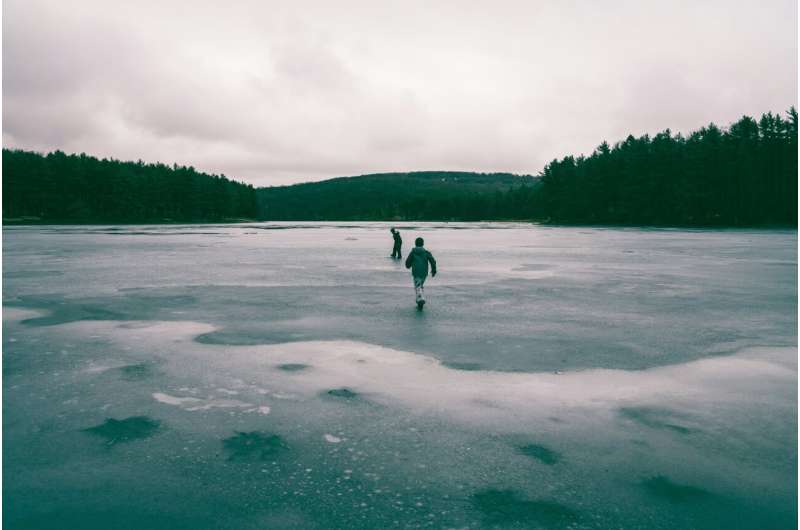This article has been reviewed according to Science X's editorial process and policies. Editors have highlighted the following attributes while ensuring the content's credibility:
fact-checked
trusted source
proofread
Video: Great Lakes ice hits historic low

For the second consecutive year, ice cover on the Great Lakes remains significantly below average for this time of year, which typically sees the peak of ice cover at levels around 53%. As of February 11, total ice coverage across all lakes measured a mere 2.7%. Lakes Erie and Ontario are basically at—or tied with—their respective historic lows for this time of year, making both essentially ice-free.
This record low ice cover is largely attributed to unusually warm temperatures throughout the region in December, paired with the generally short duration of Arctic air blasts.
The weather patterns prevailing in December play a crucial role in determining a season's ice conditions. In recent years, numerous Decembers have exhibited above-average temperatures, with this winter notably featuring significantly warmer conditions. The delayed formation of ice due to the lack of cold air early in the season makes ice concentration harder to achieve.
Winter temperatures that are well above average have continued across much of the region surrounding the Great Lakes. Minnesota, Wisconsin, and Michigan are all experiencing their warmest meteorological winter (December through February) to date. Meanwhile, New York, Pennsylvania, and Ohio are experiencing their second, third, and fourth warmest meteorological winters.
January 2024 did see some periods of cold, but they were not sustained long enough to allow ice coverage to increase, peaking at 15%–20% during the third week of the month. Typically, maximum ice cover usually peaks in late February or early March, with the Great Lakes consistently reaching a basin-wide maximum in annual ice coverage of about 53% since reliable satellite data collection began in 1973.
However, over the last 50 years, the amount of ice has dropped about 5% each decade, amounting to a 25% decrease. In addition, the duration of the Great Lakes' ice season has shortened by approximately 27 days on average over the same timeframe.
Factors that drive the lack of ice include climatic variables such as the El Niño-Southern Oscillation (ENSO) in the Equatorial Pacific along with other global oceanic oscillations, which push mild Pacific air north. These atmospheric patterns in the ocean influence weather patterns in the Great Lakes region. Rising air temperatures and "heat memory" of the lakes, retaining heat from the summer temperatures, further exacerbate the lack of ice.
Although El Niño may have worsened this year's low ice coverage, the increased occurrence of low ice years across the lakes correlates with consistently warmer winter conditions, characterized by fewer and generally shorter intrusions of Arctic air into the region. While much of the Continental U.S. has seen a warming trend during the winter months, the upper Midwest/Great Lakes regions have seen some of the most dramatic.
Ice plays an important role in the ecosystems, economy, and coastal resilience of the Great Lakes. It is a natural part of the yearly cycle of the Great Lakes, upon which many animal species, ranging from microbial to larger fauna, rely on for protecting their young and harboring eggs. The lakes also see most of their significant storms and large wave events during the colder months of late fall through winter.
The ice sheets along the shore act as an important buffer against these waves, protecting the coast from erosion and damage to shoreline infrastructure. In years with very low ice cover, such as the current one, the coast becomes more susceptible to the full force of wave energy.
Low ice coverage also affects a variety of tourism and recreation industries, such as ice fishing and outdoor sports. Last month, the John Beargrease Sled Dog marathon, one of the most beloved dog sled competitions in the Midwest, was canceled due to lack of snow.
Lake Superior typically sees peak ice cover mid-February to early March. With the forecast looking much warmer than average for the next few weeks, it's unlikely that we'll see a significant increase in ice cover this season. The Great Lakes are the largest freshwater ecosystem on Earth, and according to the Fifth National Climate Assessment, they are among the fastest-warming lakes in the world.
The NOAA-20, NOAA-21, and Suomi-NPP satellites orbit the Earth from pole to pole at an altitude of 512 miles, providing high-resolution imagery and taking temperature and moisture measurements throughout the atmosphere.
The GOES East geostationary satellite, also known as GOES-16, keeps watch over most of North America, including the contiguous United States and Mexico, as well as Central and South America, the Caribbean, and the Atlantic Ocean to the west coast of Africa. The satellite's high-resolution imagery provides optimal viewing of severe weather events, including thunderstorms, tropical storms, and hurricanes.
Provided by NOAA Headquarters





















